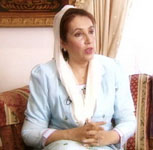New questions arise in killing of Benazir: NYT
Lahore, Dec 31: Doctors at the hospital where Benazir Bhutto was given  treatment before she expired last Thursday, have claimed that they faced considerable government pressure to confirm accounts of Bhutto’s death, including her final moments.
treatment before she expired last Thursday, have claimed that they faced considerable government pressure to confirm accounts of Bhutto’s death, including her final moments.
Athar Minallah, a board member of the hospital where Bhutto was treated, released her medical report along with an open letter showing that her doctors wanted to distance themselves from the government theory that she had died by hitting her head on a lever of her car’s sunroof.
In his letter, Minallah, who is also a prominent lawyer, said the doctors believed that an autopsy was needed to provide the answers to how she actually died. The local police chief denied their request for an autopsy on Thursday.
Pakistani and Western security experts said the government’s insistence that Bhutto was not killed by a bullet was intended to deflect attention from the lack of government security around her.
On Sunday, Pakistani newspapers covered their front pages with photographs showing a man apparently pointing a gun at her from just yards away.
Her vehicle came under attack by a gunman and suicide bomber as she left a political rally in Rawalpindi, where the Pakistani Army has its headquarters, and where the powerful Inter-Services Intelligence agency has a strong presence.
Her supporters, ordinary Pakistanis and medical experts have greeted the government’s explanation of how Bhutto died with disbelief.
While exhuming the body could clear some of the mystery, it is not clear whether the Bhutto family would give permission, such is their distrust of the government.
Minallah said that the doctor who wrote the report, Mohammad Mussadiq Khan, the principal professor of surgery at the Rawalpindi General Hospital, told him on the night of Bhutto’s death that she had died of a bullet wound, The New York Times reported.
Dr. Khan declined to speak with a reporter through Minallah on the grounds that he was an employee of a government hospital and was fearful of government reprisals if he did not support its version of events.
The medical report, prepared with six other doctors, does not specifically mention a bullet because the actual cause of the head wound was to be left to an autopsy, Minallah said.
But the chief of police in Rawalpindi, Saud Aziz, "did not agree" to the autopsy request by the doctors, Minallah said in his letter.
The question of an autopsy has become central to the circumstances of Bhutto’s death because of conflicting versions put forward by the Pakistani Government.
On the night Bhutto was assassinated, an unidentified Interior Ministry spokesman was quoted by the official Pakistani news agency as saying that she had died of a "bullet wound in the neck by a suicide bomber."
The next day, Brigadier Javed Iqbal Cheema, the Interior Ministry spokesman, recast that version of events, saying that Bhutto died of a wound sustained when she hit her head on a lever attached to the sun roof of the vehicle.
"Three shots were fired but they missed her. Then, there was an explosion," Brigadier Cheema said.
The new images of the men who appear to have been Bhutto’s assassins showed one dressed in a sleeveless black waistcoat and rimless sunglasses, and holding aloft what appeared to be a gun.
He had a short haircut and wore the kind of attire reminiscent of plainclothes intelligence officials, though Al Qaeda and other militants have also been known to dress attackers in Western-style clothing in order to disguise them, The NYT reported.
That man is seen standing in front of another whose head is covered in a shawl in the style of Pashtun men from the Pakistan’s tribal areas, where Al Qaeda has regrouped in the past year. He is described in a local Pakistani daily as the suicide bomber.
Minallah said Bhutto’s doctors raised the likelihood of a bullet killing her in their report, when they wrote, "Two to three tiny radio-densities underneath fracture segment are observed on both projections."
The report said the doctors tried for 41 minutes to revive her. It said "the patient was pulseless and was not breathing," when she arrived at the hospital. "A wound was present on the right temporoparietal region through which blood was trickling down and whitish material which looked like brain matter was visible in the wound," it said.
An account of her death that did not involve a gunshot wound was the optimal explanation for the government, said Bruce Riedel, an expert on Pakistan at the Brookings Institution in Washington, and a former member of the National Security Council in the Clinton administration.
"If there is a gunshot wound, the security was abysmal," Mr. Riedel said. The government did not want to be exposed on its careless approach to security, he said. (ANI)